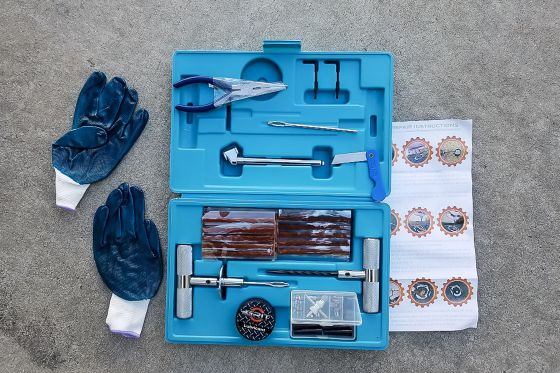Truck Stuck? Use a Tire Repair Kit to Get Out of the Wilderness
There are dangers to traveling off-pavement. Annoyances like pointed rocks in the mountains, buried sticks in the mud of the lowlands, spikey brush in the desert or old pieces of metal near railroads can easily puncture a truck tire. To mitigate the risk of being stranded, those who spend a significant amount of time traveling off-road or overlanding will often carry two spare tires. Another handy emergency item is a tire repair kit.
There are a variety of tire repair kits on the market ranging from less than $10 for cheap plastic kits to more than $50 for high-quality kits with lots of spare parts. These aren't permanent fixes, but a temporary fix to get you out of harm's way to the nearest repair shop, or far enough out of the woods to install a spare for safe highway travel. The tire kit we tested is from Grit Performance. We chose this kit because it features all-metal tools and a significant supply of spare parts and pieces to repair many types of flats. It runs about $30 on Amazon and comes with gloves, instructions, all the tools needed to plug a tire and a few other items.
How to Plug a Tire
Plugging a tire is simple and a great thing for any outdoor-oriented person to learn. Here's how:First, determine where the leak is coming from and what caused it. Some leaks are hard to find, in which case water (preferably soapy water) can be used to help locate the leak. Soapy water will bubble up from the escaping air. If the hole is in the sidewall, then the tire is no longer structurally safe and will need to be replaced. However, the hole can still be plugged in an emergency to get the vehicle back to civilization. If the leak is coming from the valve stem, then the valve stem needs to be replaced. The most common place for a leak to occur is in the tread where the tire meets the ground, and these are the types of leaks on which a plug kit works best.
Once the leak has been found and determined to be repairable, there are a few simple steps to follow and tips to make things go a little easier. It's best to read through all the manufacturer's instructions before starting, that way everything can be set up for the next step. This is especially useful if the tire isn't completely flat yet, as some pressure can be retained throughout the repair process.
The steps for plugging a tire are illustrated below; photos appear underneath the step described.
1. The first step is to remove the obstruction from the tire. In our case there was a screw with a worn-down head stuck in the tire.
2. Use the reamer tool to clean and prep the hole for the plug. Lubricant can be applied to the reamer to make the job easier. The reamer should be run back and forth many times. This will clear any debris out of the hole and separate the steel belts to make room for the plug. The reamer can be left in the hole to prevent more leaking while the next step is completed.
3. Thread the plug halfway through the eyelet of the plug insertion tool and if desired, apply lubricant to the tool. It may be easier to slide the plug into the open end of the eyelet rather than pulling the plug through the eyelet on some tools. Most plug kits available today come with self-vulcanizing tire plugs, so no additional glue is needed. However, for larger holes that require more than one plug, or for plugs that don't come with a vulcanizing glue on them, coat the plug and the hole with a glue designed for tire repair.
4. Remove the reamer from the hole and insert the plug. This may require a lot of force, but a tight fit helps seal the hole. Be sure to leave between 1/4 inch and 1/2 inch of the plug sticking out of the tire.
5. Remove the plug insertion tool. With higher quality kits, the plug insertion tool will have a large flat area to use as leverage to hold the plug in the tire while removing the plug insertion tool. If using a kit without this, be sure to remove the plug insertion tool quickly while using something to hold the plug in place.
6. Cut the excess plug just above the surface of the tire, not even with it. Leaving 1/16 inch to 1/8 inch of plug sticking out of the tire will allow the plug to spread on the outside of the tire while driving to create a better seal.
7. Reinflate the tire to the desired pressure and check for leaks. With most kits, it's OK to drive on the tire by the time you have cleaned up the tools and put everything away, but be sure to follow the manufacturer's recommendations.
Bonus Tips for Off-Road Explorers
Only use the spare tire as a last resort. If driving on terrain where damaging a tire is likely and a puncture has already occurred, try to repair any leaks in the punctured tires. It's possible to have a puncture on the same tire multiple times. Rather than switching for a spare tire and possibly getting a flat in the spare, repair the tire and let it get damaged again. Once safer terrain is reached, the spare can be put on if needed for safe highway travel.Sidewalls and shoulders flex significantly more than the tread of a tire. This flex is more likely to cause a plug or patch to fail, or for the tire around the plug or patch to fail. For this reason, repairs in the sidewall are not safe for highway travel. Making these repairs to get back to pavement may be necessary, but never travel at a high rate of speed with a sidewall repair.
When plugging a large hole or cut, multiple plugs can be used. Remove all the air from the tire before starting a repair on a large hole. To be sure that everything is properly sealed, use a generous amount of tire repair glue and allow a little extra time for the glue to dry before driving. If a hole does require more than one plug, it should not be driven at high speeds or on highways until it has been professionally inspected and repaired or replaced.
While our kit didn't come with extra valve stems or glue, it's a good idea to have these items. We have since purchased the proper valve stems for our vehicles and a small tube of tire repair glue for a few dollars each, both of which fit nicely in the kit.
Conclusion
In the wilderness, being able to quickly repair a tire and be on your way can be an important or even a life-saving skill. In an urban setting, this isn't an issue as there are tire repair shops in almost every town and city across America. Repair kits are inexpensive and the process is easy, so if you frequently drive the road less traveled, be sure to pick one up and learn how to use it.
Do you want to get the more information about wheelchair vans and van shelving, then please contact us in the comment section and send your queries regarding this.















Comments
Post a Comment